Matador Network's Blog, page 569
October 27, 2021
The perfect gifts to inspire a love of science in your kids

When you can grant your child an item or an experience that will not just entertain them, but also educate them, and, even better, get them inspired to learn more, you have given them a gift bigger than the actual present itself. And it’s worth more than the money paid for it. Here, then, are kids gifts meant to inspire in your child a love of science and the natural world.
Family membership to a science museum
Photo: Monkey Business Images/Shutterstock
Many cities have a science museum, some have even more. (San Francisco has both the Exploratorium and The California Academy of Arts and Sciences, while Chicago has the Museum of Science and Industry, The Field Museum, and the Adler Planetarium). When you buy a membership to one, you’re not just supporting an important institution, you’re making it easy to visit the museum frequently and in small, digestible chunks. Choose the one that is the most convenient for you, and take advantage of weekend or evening family events as well. Many museums have partnerships with others in the country, so you can include visits to other science museums when you travel.
Science books for kids
Photo: Guinness World Records
There’s hardly a better way to get kids inspired about science than to have them read about it on their own through age-appropriate books on the natural world. Can You Hear the Trees Talking? is a wonderful, interactive book for pre-teens, by Peter Wohleben, author of the bestseller, The Hidden Life of Trees. The Fascinating Science Book for Kids: 500 Amazing Facts is like a Guinness book of unexpected facts that will make clear why studying the world is so darn cool. As the nights get longer, kids will also appreciate a primer on the night sky, as in Constellations for Kids. Also, look for books that teach kids why science matters. Mark Twain — Forensic Investigations teaches kids how to use science to solve crimes.
If your child is more of a doer than a reader, get a book that offers up cool science experiments they can do themselves, like Awesome Physics Experiments for Kids that detail experiments they can do at home and why they work, or The Everything Kids’ Science Experiment Book written by a science teacher.
Science fiction books and films
Photo: Dune Novels
Yes, you read that right: science fiction. Science fiction depicts aspects of the future that scientists often work to turn into reality — from phones you can hold in your hand to interplanetary travel. Our eldest daughter, who’ll soon graduate from college with degrees in astronomy and physics, says the Sci-Fi books and movies we shared helped spark her own fascination with space. Whether the classic A Wrinkle in Time, the campy original Star Trek series or the more teen-appropriate Avatar, books and movies show us where science can go. And before your tween or teen goes out to see Dune in theaters (which they should), have them first read the award-winning novel.
Science sets
Photo: Shop Disney
Before you rush out to buy a science kit, first consider what situations your kids will be in while using them. Most of the better science kits will demand some of your time — since they involve liquids and colors that can make a mess (at best). National Geographic makes a bunch of great kits that know how to get kids excited about science. Their Science Magic Kit lets kids use science to make “magic tricks” like making snow disappear, while the Super Gross Chemistry Set lets them do icky experiments and learn why they work. With their Earth Science Kit, kids can grow an actual crystal or make a “volcano” erupt.
Microscopes, binoculars, and telescopes
Photo: Rido/Shutterstock
Each of these items nurtures a very different kind of science. While telescopes are best for kids interested in astronomy, and binoculars might suit your budding ornithologist or marine biologist, depending what she is looking at, microscopes might conjure up a love of biology, as they can be used to look at small organisms, but budding chemists and even geologists will find a hidden world made visible through the use of a microscope. You’ll find starter kids’ microscopes for as little as $39.99 and going up to ones for juniors at $89. Binoculars for kids will let them take in the natural world in a new way, while telescopes will be a good complement to the Constellations for Kids book noted above.
Snap Circuits and magnets
Photo: Elenco
Snap Circuits are like Legos with electricity, allowing kids to make all kinds of things and have them actually work, because of the small electric current that runs through it. It’s a great way to inspire budding physicists and engineers. Start with the basic set and, from there, you can take it all the way to the larger set offering dozens of complex combinations of components. You can get your little ones building with Magna-Tiles and from there spark and interest in the cool things that magnets can do.
Rockets
Photo: Supamotion/Shutterstock
There’s nothing like sending a rocket soaring into the sky, or even just a few yards off the ground. As long as you have space outside and are able to supervise, your kids will have a ton of fun launching these slender rockets into the air. 
October 26, 2021
The best places to eat and sleep if you are visiting NYC this fall

Seasons change, and so does New York…or so I thought, until I was pleasantly surprised with a return after two years. Though high-rise buildings and oat milk-themed cafes continue to pop up in my beloved Brooklyn, there is still a pulse of community and celebration that no pandemic or hipster can erase. Fall in NY has always been a sweet spot to me, when the weather changes from unbearable to breathable, and the leaves show off with a kaleidoscope of colors. It’s the time to roam as much as possible before winter hibernation.
To that end, if you’re looking to hit the streets of NYC before the chill sets in (or even when it does), here are a few places to get you started.
CHECK INArlo Soho
This location is a great middle-ground for those looking to commute between the city and Brooklyn. Arlo has three NYC locations (the other in Midtown and NoMad) and often hosts on-property events for guests. It’s a place where wellness and just working well is easy– with a number of coworking spaces including the rooftop, as well as partnerships with Allure Magazine that includes a beauty bag upon check-in, as well as a series of pop-up events such as cocktail parties and beauty sessions. There are 325 efficiently built rooms, meaning, no-frills, but gets the job done– and the panoramic views of the city from some rooms don’t hurt either.
Rates starting around $300

ArloSoho/Guest Room
Langham
For a bit more luxury and views, head uptown to the Langham. This Midtown fixture still has that classic New York City feel– refined without being restrained, with those classic Chuan amenities in each of its 234 rooms, a Michelin starred restaurant, Ai Fiori, and views of the Empire State Building.
Rates starting around $600
Veranda Soho
Just walking distance from Arlo Soho, Veranda is a great place to meet up with friends or just people watch. The menu is the kind that’s difficult in the best possible way: with so many delicious sounding dishes that it’s hard to narrow down. If you are having trouble, I’d highly recommend the Maine lobster, served chilled with a corn puree, or the very generously portioned salt cod and potato casserole, layered with caramelized onions and olives.
Entrees from $27
Junoon
In Flatiron, Junoon is an extraordinary testimony to just how layered, textured and satisfying Indian food is. Black wood doors open to a sexy and subdued dining room. Pull up a chair at the bar for a classic martini, or, dine outside in one of their very pandemic friendly open air booths. Don’t skip experiencing the cocktails, like the “Mumbai Margarita,” which includes a reposado tequila, mango purée, lime, rose-chili syrup, and spiced salt. For starters, get the fall-off-the-bone masala ribs and tandoori octopus. For mains, a classic murgh lababdar (tandoor grilled chicken) or lamb chops with a side of yellow daal will not disappoint. The restaurant’s fall marketplace at the front of the restaurant will feature signature items like their tea and spice blends, boxes of hand-painted chocolates and more.
Entrees from $25
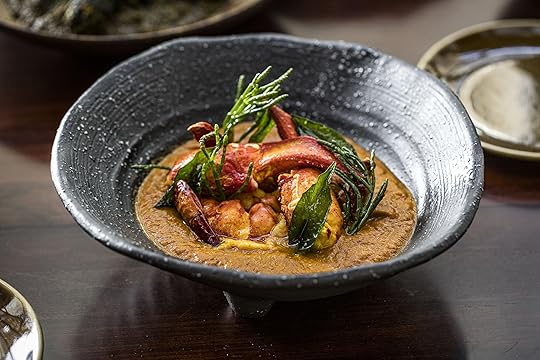
Eric Medsker/Lobster Curry at Junoon
The Musket Room
What’s a visit to NYC without a proper brunch? When it comes to this trendy and frequented pastime, a place that you can actually count on good food is The Musket Room. I’ll start by waxing poetic over the creations of their in-house pastry chef, Camari Mick, who blessed my friend and I with pan con oishi berry gelato and pistachios that was just toe curling good. In the summer, get your hands on the King Crab roll that can be topped with caviar, if you’re feeling decadent. For brunch, there’s a grilled skirt steak, fries, classic port wine cream sauce and egg sandwich with toasted portuguese roll, scrambled egg, vermont cheddar, avocado, smoked bacon, piri-piri mayo, french fries. The fall menu highlights local produce with dishes like a hearty squash risotto with truffle and hazelnut brown butter and Mick’s caramelized apple brown butter donut, though, in general, there’s really no item that won’t make your taste buds happy here.
Entrees from $26
Bed-Vyne Brew
Every trip should begin and end with the best city in the U.S. — Brooklyn. I was so happy (and relieved) to see that my favorite place to grab drinks was still open, with a block party happening simultaneously and Wadadli Jerk to grab some jerk pork parked right in front.
Entrees from $10
Kokomo
For Caribbean food, music and vibes, head to Kokomo in Williamsburg. Couple Ria and Kevol Graham own the always lively spot, with Chef Christian Aranibar serving dishes from the kitchen that include flatbread topped with braised oxtails, sautéed ackee and shrimp, and vegan dishes like lentil meatballs served with a Trinidadian ginger coconut curry sauce.
Entrees from $19
Are houses on Airbnb really more affordable than hotels? This data set says no.

Are you team hotel or team Airbnb? The two choices each have strengths and weaknesses depending on the experience you’re looking for, but for many it comes down to cost. And while Airbnbs are often praised for being the cheaper option, in May users took to social media to complain about the company’s listings and added costs after booking.
To settle the debate on whether Airbnbs or hotels are more affordable, the site Upgraded Points conducted a study with data points from hotels and Airbnbs in US major cities to find out how to give your wallet a break.
In 2017, 81 percent of Airbnb’s revenue came from whole-unit rentals, but if you’re in the minority and are comfortable staying in a private room, an Airbnb is cheaper in all 50 cities Upgraded Points looked at. The biggest difference between a private room and a hotel was in Las Vegas, where opting for a private room saves $269. It may not be worth it if you’re headed to Orlando, Florida, though, where the average savings was just $7.30.

Photo: Upgraded Points
If you’re looking to have an entire place to yourself, you’re not going to see the same return. In fact, in 46 out of 50 cities, a hotel stay is cheaper. In Los Angeles, you’re going to see a savings of almost $330 if you choose a hotel, while in Miami it’s a savings of $304. But in Atlanta, you’ll only see a savings of $2.30. So if you find the whole-house Airbnb of your dreams, it’s not going to break your bank.
Were consumers right about raising Airbnb taxes and fees? Upgraded Points says they are. An Airbnb can run you an average of over 40 percent of the listing cost in taxes and fees, and in some cities like Orlando, you might see that go up to 50 percent. Comparatively, hotels average a little over 15 percent of taxes, with the peak reaching 22 percent in Las Vegas.

Photo: Upgraded Points
Of course, Airbnbs tend to offer more unique stays than a regular hotel room, like luxurious yurts in the winter, a cabin in the hills of Kauai, or a tiny house in upstate New York. Ultimately, the best stay is the one that’s best for you and your travel goals. 
This tequila honors the diverse Dia de los Muertos celebrations in Central and South America

Dia de los Muertos, or Day of the Dead, is a time to celebrate those who have passed. Meals are shared, sugar skulls are decorated, graves are visited, and drinks are poured. Different regions of Central and South America observe the holiday, which lands on November 1 and 2, in different ways. A recently revamped tequila called KAH honors the traditions in Bolivia, Peru, and Nicaragua.
“Kah” is Mayan for life. It’s made in the town of Tequila from agaves that grow in both the Highlands and Lowlands region of Jalisco, Mexico. The painted ceramic bottles are different for every expression: the blanco is a white bottle that draws from Bolivian traditions, the reposado in an orange bottle to honor Peruvian traditions, and a black añejo bottle in reference to Nicaraguan traditions.
One thing the bottle designs have in common: Each has art that’s representative of the respective country’s traditions around death.

Photo: KAH Tequila
In Bolivia, coca leaves, llama meat, and chicha (a fermented corn drink) are all left at altars on Day of the Dead. Cemeteries are filled with music from a type of flute called the pinkullus. In some households, the food and flowers is put under the table to represent the underworld (Uma Pacha); the base of the alter gets coca leaves, chicha, and fruit to represent the lowlands; the table represents the highlands with beer and other snacks; and a sugarcane cross represents the heavens.
It’s a week later that skulls are especially important to Bolivian traditions. On November 8, people bring out ñatitas, which are decorated and carefully preserved human skulls. The skulls didn’t necessarily come from family members — they instead come from medical schools, archeological sites, local cemeteries that have turned over plots, or have been passed down through the family over centuries, according to Smithsonian Magazine.
The tradition dates back to the Aymara people from the Altiplano region of the Andes, who viewed the afterlife as another plane of existence and the ñatitas as vessels for the soul that can offer fertility, luck, and protection.
KAH represents this with a painted white skull, though in Bolivia the ñatitas are often decorated with flower crowns, cigarettes, and alcohol.

Photo: KAH Tequila
In Peru, the November celebration is called Dia de los Difuntos, or Day of the Deceased, and can be traced back to Inca traditions. Today, people travel to gravesites to share a meal and leave food for the souls journeying to the afterlife. Lechon (suckling pig) as well as tanta wawa (breads shaped and decorated like baby dolls) are common, as are breads shaped like horses, crowns, and stairs.
After Spanish colonization, Indigenous peoples here and elsewhere in Latin America had Catholic holidays (in this case All Saints Day and All Souls Day) forced on them. They merged the holidays with their own traditions to keep them alive. Some in Peru, for example, mummified their dead and honored their ancestors with processions including food and drink. That was replaced with the early November holiday.
KAH’s art design on the Peruvian-inspired bottle has another reference to the region’s traditions as well: a winged red devil on the top of the skull. This is related to the Peruvian tradition, also practiced in Bolivia, of dancing in masks to appease the devil and keep the living safe.

Photo: KAH Tequila
And then there’s KAH’s añejo, which is inspired by the Nicaraguan tradition of sleeping in the graveyard on Dia de los Muertos to connect with those who’ve passed.
The three tequilas represent just three of the many ways that people celebrate Dia de los Muertos and other traditions that honor the dead. They’re one way to get a taste of just how diverse the holiday is across Central and South America.
This small, retro-looking car is a modern hotel room on wheels

French designer Matthieu Lehanneur created a small, simple, and retro-looking answer to our desire to escape on a whim: Suite N°4, a concept car that’s nothing short of a beautiful modern hotel room on wheels.
Suite N°4 is a contemporary take on the Renault 4L, a car that every French person above the age of 30 fondly remembers. The Renault 4L is a small, rounded, and optimistic-looking vehicle that was created 60 years ago.
Much like the well-known 2CV, there was a time when just about everyone in France had a Renault 4L — Farmers, young drivers, and racers on the Dakar Rally included. The Gendarmerie (the French military police) had them in a shade of dark blue, bakers around the country drove them to make their morning deliveries, and the employees of La Poste (the French national postal system) drove bright yellow 4Ls on their errands.

Photo: From top left to bottom right,Richard Walker Media, Rudiecast, olrat, luis abrantes via Shutterstock
While sadly you don’t see as many 4Ls on the streets of France any longer, Matthieu Lehanneur’s design gives us the hope of a revival.
In creating Suite N°4, he kept everything we love about the 4L — its shape and size — while adding some stylish and very much on-trend elements. For one, unlike its 1960s inspiration, it’s electric. And while there’s still thick, old-fashioned corduroy fabric on parts the seats and on the roof, it’s mixed with neon yellow color on the dashboard, the seatbelts, the mirrors and the front seats for a fresh look. But, of course, the biggest change is the transparent polycarbonate windows on the canopy and the back half of the vehicle.

Photo: Renault/Facebook
Suite N°4 is a two-seater, as the trunk and back seats spaces have been transformed into a cozy bed. There’s even a well-hidden table that can be pulled out from below the tailgate. No need for a van to take yourself off the grid, Suite N°4 will do as a modern hotel suite on wheels.
Voir cette publication sur InstagramUne publication partagée par Mathieu Lehanneur (@mathieulehanneur)
“This vehicle cares less for performance than it does for experience,” Lehanneur said in an Instagram video. “It’s an open-air hotel room that is much better than a suite in a fancy palace, because you can take it anywhere, whether that’s by the sea, in the middle of a field, or in your dream city.”
While Suite N°4 is a concept car and Lehanneur’s design may never see a manufacturing belt, it’s still a great example of how to rejuvenate and modernize a beloved vehicle without losing its original essence.
If you want to see Suite N°4, it will be on show at the Maison & Objet fair in Paris from January 20-24, 2022. 
6 ways to stay cozy this winter
 Want to stay extra cozy this winter? Enter our sweepstakes and win a weekend at a Getaway House cabin in the Western Catskills, New York, along with your very own Columbia Omni-Heat Infinity Jacket!
Want to stay extra cozy this winter? Enter our sweepstakes and win a weekend at a Getaway House cabin in the Western Catskills, New York, along with your very own Columbia Omni-Heat Infinity Jacket!Enter here!
If “winter weather” is code for “hiding under the covers” in your vocabulary, remember this dose of Norwegian wisdom: “There’s no such thing as bad weather, only bad clothing.” While you can’t upgrade the weather, you can upgrade your gear — particularly with Columbia’s sleek new Omni-Heat Infinity line. Its signature feature? Gold.
The precious metal lines the world’s most innovative gear, from astronaut helmets to Columbia Sportswear, thanks to its reflective properties ideal for heat amplification. For outdoor lovers, that means all-day warmth for a winter full of fresh-air excursions, whether it’s hitting frozen trails like the Norwegians or hopping from one quaint coffeeshop to the next like the Danes.
Of course, proper clothing isn’t the only winter hack to learn from high-latitude cultures. Here are six ways to stay cozy and warm all winter, whether you’re in the States or jet-setting abroad.
1. Go hygge-hopping like the Danish
Photo: Maria Evseyeva/Shutterstock
Few cultures embody hygge — a high-latitude quality of coziness, comfort, and contentment — like the Danish. Take their warm and charming bistro and bar culture as proof. Cozy digs abound throughout Danish destinations like Copenhagen, whether it’s the café-lined and cobblestone Jægersborggade block or the colorful Nyhavn district. Here, travelers and locals alike go not just bar-hopping, but “hygge-hopping,” from one charming waterfront venue to the next.
But you don’t have to travel abroad to try your hand at the cozy fun. Seattle is one of America’s ultimate hygge capitals, and the city’s Pioneer Square, a cobblestone expanse that glows beneath strings of warm lights, is a great place to practice this Danish pastime. Hop from quaint coffeeshops like Elm Coffee Roasters to cozy cocktail bars like Damn the Weather, and don’t forget to zip up that Columbia Omni-Heat Infinity jacket to stay toasty from points A to Z.
2. Experience a Finnish sauna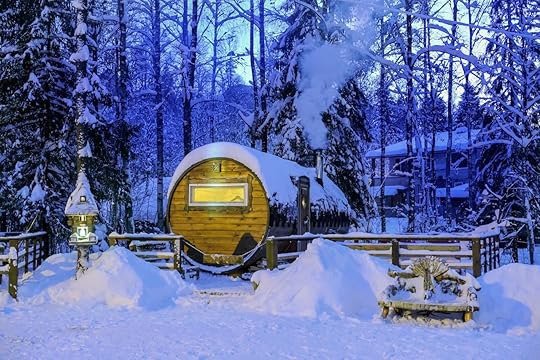
Photo: Lana Kray/Shutterstock
Finland takes its sauna-going seriously, to the point that Finnish saunas made the UNESCO Intangible Cultural Heritage List in 2020. This isn’t your typical resort steam session: In Finland, sauna patrons sweat, sans clothes, in a space heated anywhere from 170º to 230º Fahrenheit. Then, still naked, they run outside and leap into a frigid lake or river, or roll around in the snow, before heading back into the steamy sauna to rinse and repeat.
You can try this “UNESCO experience” throughout Finland — there are a whopping two million saunas speckled across the country. But even stateside, there’s a movement to make Finnish-sauna culture mainstream. Head to Minneapolis, where the Kickstarter-funded 612 Sauna Society, a community-owned mobile sauna unit, lets folks partake in the Finnish tradition. And, while this experience is often clothes-free, it’s always handy to have your Columbia Omni-Heat Infinity layers ready to keep those cozy vibes going well after the steam evaporates.
3. Soak in hot springs like the Icelandic
Photo: Try_my_best/Shutterstock
It’s hard to beat a winter dip in Iceland’s mineral-rich hot springs. Dreamy pools like the Blue Lagoon may get all the Instagram attention, but you can soak in naturally warmed waters across the country, from Golden Circle-adjacent Secret Lagoon — heated by three nearby geysers — to the far-north Mývatn Nature Baths, where steamy, swimmable springs overlook snow-capped mountains and, if soakers are lucky, an ethereal aurora display.
The US may not have the hot-springs density of Iceland, but northern getaway Fairbanks, Alaska, gives the “Land of Fire and Ice” a run for its money. At Chena Hot Springs, you can soak in steamy, snow-ringed pools beneath a shimmering sky of Northern Lights. Or zip up that Columbia Omni-Heat Infinity gear and check out Chena Hot Springs’ onsite Aurora Ice Museum, a year-round ice-art venue created from 1,000 tons of ice and snow.
4. Get your heart pumping like the Norwegians
Photo: Columbia Sportswear
Movement keeps the body warm and healthy — that’s why many Norwegians choose outdoor adventures over a winter full of Netflix bingeing. The country’s winter activities run the gamut, including cross-country skiing, dog sledding, and simply hiking along snow-dusted trails. And winter-adventure perks extend well beyond warmth: Staying active outside can help cure the winter blues.
Like Norway, Colorado offers a blend of snow-capped mountain scenery and serious outdoor adventures that make braving the cold a breeze. Try snowshoeing at Black Canyon of the Gunnison National Park, snowboarding at Breckenridge or another world-class mountain resort, or cross-country skiing around Crested Butte. Don’t forget the Norwegians’ advice, and invest in warm gear like Columbia’s Omni-Heat Infinity jackets and pants to stay warm throughout Colorado’s wild and action-packed winters.
5. Sit beneath a heated table like the Japanese
Photo: Japan_room/Shutterstock
Winter in Japan may bring to mind epic snowboarding and skiing, but one of the country’s greatest cold-season inventions promises unparalleled coziness after a day on the slopes: the kotatsu heated table. These tables, situated low to the ground and placed in a main sitting area, are like a high-end campfire. Loved ones sit around the toasty table and soak up the warmth, generated from an electric heater, while chatting, reading, or enjoying that time-honored post-slopes activity: napping.
You don’t have to jet-set to Japan to enjoy this coziness. Grab your Omni-Heat Infinity jacket and hit the streets of New York City’s Chinatown, where the new Dr. Clark restaurant allures winter diners with its own kotatsu table — not to mention digs that mirror Japan’s northernmost island, Hokkaido.
6. Wear the right gear for all-winter fun
Photo: Columbia Sportswear
Whether you’re ambling from coffeeshop to coffeeshop or hitting the trails for a much-needed dose of winter sunshine, don’t forget that sage Norwegian advice: “There’s no such thing as bad weather, only bad clothing.” Columbia’s new Omni-Heat Infinity line is the definition of smart winter clothing, the gold standard of warmth in a chilly world. 
October 25, 2021
Why anyone who loves waterfalls needs to plan a trip to Southern Idaho

“When you hear people talk about the waterfalls in Southern Idaho, they’re almost all going to start with Shoshone Falls,” Paul Melni, the owner of AWOL Adventure Sports in Twin Falls, Idaho, told me as we got into a pontoon on the Snake River.
The reputation is well earned: Known as the “Niagara of the West,” Shoshone Falls is 212 feet high and some 900 feet wide. In peak season, about 900,000 cubic feet of water drop off the rim every minute — about the same amount of water in the Lincoln Memorial Reflecting Pool, or the equivalent of about 10,000 basketballs falling over the edge every second.
But we were on the Snake River in September, which is a time of year that the “Niagara of the West” looks more like a white-washed cliff on another planet than one of the most striking cascades in North America. From late summer through winter, the water is diverted to quench the region’s farmland. Passionate waterfall chasers expecting to kayak alongside the thundering deluge may find this disappointing, but it’s just an excuse to venture out to explore the seemingly endless number of other falls across Southern Idaho.

Photo: Visit Idaho
Melni directed the pontoon east toward Pillar Falls. This stretch of the Snake River — the ninth longest river in the United States — between the town of Twin Falls and Shoshone Falls is the only way to get to the locally loved Pillar Falls. It’s also one of the most striking sections of the river thanks to the massive Snake River Canyon. Every so often on the ride, Melni interrupted himself to point out another waterfall coming from the canyon walls, which can reach up to 500 feet high from the base.
Along with waterfalls, there’s another eye-catching sight along the way: BASE jumpers leaping from the I. B. Perrine Bridge and parachuting down to the canyon floor. It’s the only bridge in North America where people can BASE jump year-round, and we saw a handful of people take the plunge in the time it took for Melni to slowly steer the boat under the bridge.
Yet we were there to see waterfalls, not adrenaline seekers. In particular, Pillar Falls. On Google Maps, our destination looks like it’s underwater. An outcropping of rocks about a mile and a half from the boat launch at Centennial Park says otherwise.
Pillar Falls is named after twin boulders that tower above the rocks. Water rushes around the rocks that stick out enough to climb and walk across, and clear pools of water sink dozens of feet down. Looking into them reveals fish and crawfish stuck in the pools until the high water season returns. The Bonneville Flood that happened about 17,400 years ago brought the boulders to this part of the Snake River. Some boulders got stuck on the bottom, Melni explained as we hopped from rock to rock, and the rushing river caused the rocks to spin and drill the deep pools over the ensuing centuries.

Photo: Nickolaus Hines
People can take a dip into the larger bodies of water, and AWOL has held Scuba training courses in the deepest ones. I strolled along and got my feet wet where the flow was most gentle. It’s relaxing, to say the least, to be in a spot accessible only by boat with your feet in the cool, clear pools and nothing but the sound of birds and rushing water in the air.
Pillar Falls is a worthy destination in and of itself, but it’s also a stopping point for kayakers heading all the way to Shoshone Falls. Through AWOL, you can join a tour to the base of Shoshone falls, and crew members will haul your kayak across the rocks by Pillar Falls so all you have to worry about is the paddling.

Photo: Photo: Sarah Rohrbach / Visit Idaho
Pillar Falls was just the start of a week in Southern Idaho that I spent falling for falls. The region is overflowing with thousands of waterfalls around the canyon and elsewhere.
At Kelley’s Canyon Orchard, a working pick-your-own orchard and fruit stand with an historic farm-stay Airbnb, a waterfall on the canyon wall side of the property is the primary water source for the cherries, apricots, peaches, pears, nectarines, plums, apples, tomatoes, and melons. It’s also a lovely backdrop and soundtrack to any time spent among the trees. At Ritter Island in Thousand Springs State Park, you’ll find water gurgling out of the surrounding canyon walls and falling to the river below just about everywhere you look.
The seemingly endless number of waterfalls in the region come thanks to the Snake River Plain Aquifer. It covers some 10,000 square miles of Southern Idaho, or about the size of Lake Erie. As Boise State Public Radio notes, the water comes from mountain snowmelt and flows through porous basalt rock that formed from volcanic eruptions millions of years ago. While gorgeous, the waterfalls aren’t the main reason the aquifer is important to Idaho. The aquifer is how the state is able to support the expanse of agriculture and dairy farms in the region, and, by extension, support large companies in the area like Chobani and Clif Bar.
Robin Kelley, from Kelley’s Canyon Orchard, says she’s had people stay at her farm Airbnb who are passing through the area solely because they’re chasing waterfalls. It’s not a bad game plan. There’s plenty of things to do, see, and eat around Southern Idaho. Hiking at the Little City of Rocks for the Native American paintings and the area’s natural arch and hoodoo rock formations, for example. Or stopping for ice cream made from local dairy at Cloverleaf Creamery in Buhl, and ending the night at Koto Brewing or Milner’s Gate in Twin Falls.
At the heart of any trip here, however, is the water itself. The best way to see the waterfalls is to wander and chart your own path. It’s not hard to stumble upon a waterfall that would be the centerpiece of a trip if it were anywhere else, but in Southern Idaho it’s just one gorgeous waterfall among a seemingly endless crowd of gorgeous waterfalls. That said, here are some key stops you won’t want to miss.
Twin Falls
Photo: Sarah Rohrbach / Visit Idaho
Despite the name, Twin Falls is only one waterfall — the second had its stream diverted to feed a hydroelectric dam. That doesn’t mean that this natural feature that the town of Twin Falls gets its name from is any less worthy of a stop (though it’s technically located in Kimberly rather than Twin Falls). The best time to see the 125-feet-tall waterfall is March through June.
Perrine Coulee Falls
Photo: Photo: Sarah Rohrbach / Visit Idaho
No need to plan around a specific high-flow time of year for Perrine Coulee Falls. Located not far from the I.B. Perrine Bridge, this site is accessible year-round to hike near, around, and behind the 200-feet-tall waterfall. A good place for a photo-op is the Snake River Canyon Rim Trail or Centennial Park.
Pillar Falls
Photo: Nickolaus Hines
Grab a kayak or hitch a ride on a pontoon to follow the river about a mile and a half from Centennial Waterfront Park to get to Pillar Falls (or if you’re up for it, a stand-up paddleboard will get you there, too). Park your watercraft on the north side of Pillar Falls and then get to exploring the pools and drops in the area.
Ritter Island and Thousand Springs State Park
Photo: Sarah Rohrbach / Visit Idaho
Some waterfalls stand out as a singular attraction, others are defined by groups. You’ll find both here. The largest alone is worth a visit, which is near impossible to miss unless you get too distracted by the crystal clear water surrounding Ritter Island. To see springs bursting forth from the canyon wall, head over to Minnie Miller Springs a quarter mile from the Minnie Miller homestead.
Niagara Springs
Photo: Photo: Sarah Rohrbach / Visit Idaho
While it lacks a sheer cliff face drop like some of the other striking waterfalls on this list, Niagara Springs is more than worth a visit on any waterfall chaser’s itinerary. The spot is a National Natural Landmark where water falls out of the canyon walls at 250 cubic feet per second. In the warmer months, make time to visit Kelley’s Canyon Orchard across the Snake River for delicious fruit.
Earl M. Hardy Box Canyon Springs Nature Preserve
Photo: Photo: Sarah Rohrbach / Visit Idaho
Come for the wheelchair accessible viewpoint that looks over a massive waterfall, stay for the wildlife and more remote falls. Box Canyon is a bald eagle wintering ground where the country’s bird can easily be spotted alongside golden eagles. A trail down to the canyon will get you to a tumbling and remote waterfall that’s a joy in the summer.
9 games you can play even in the most cramped airplane

We hope you love the spaces and stays/products we recommend! Just so you know, Matador may collect a small commission from the links on this page
Air travel leaves a lot to be desired, but sometimes, it’s the sheer boredom of flying that’s hardest to overcome. While movies, music, books, and good old-fashioned sleep can help pass the time, these are all hard activities to share with your traveling companions on a flight. Enter airplane games. Some games can be played offline on various devices. Others require no materials at all. But it’s also possible to recreate game-night-style fun 40,000 feet in the air. Here are nine board and card games that can fit on your tray table, come with easy-to-manage pieces, and can be played side-to-side with your seatmate that are perfect for your next flight.
1. Monopoly DealMonopoly Deal is a cards-only spinoff of everyone’s favorite real-estate-themed board game. All you need to play is the 110-card deck, which comes with rule cards, action cards, property cards, property wildcards, rent cards, and money cards, as well as a small surface like an airplane tray table to draw from the deck, create a pile of action and money cards, and lay down property cards. The objective of the game is to be the first to collect three full monopolies.
2. Backpacker
Photo: Backpacker/Facebook
Backpacker is a travel-themed card game that’s easy to pack and play on the road. There are two types of cards in the Backpacker deck: country cards, which represent various destinations and the number of points each one is worth, and color-coded event cards, which issue directives that can either benefit or disadvantage players. Designed for two to six players, the game begins with everyone being dealt five cards, after which players take turns drawing and playing a card each round. When the draw pile runs out, the player with the most points wins.
3. Struggle for CatanThe makers of Settlers of Catan have released multiple versions that are fit for travelers. While the travel edition is compact enough to whip out on an airplane, the pieces are small and loose, which can be problematic on bumpier flights. A better choice is Struggle for Catan, a card game based on the Catan universe. Traveling duos might also enjoy Rivals for Catan, a two-player strategy game that feels more like a card-based adaptation of the original board game.
4. Farkle
Photo: digitalreflections/Shutterstock
Farkle is a dice game based on poker combinations similar to Yahtzee though there’s less strategy and more risk involved. The object of the game is to score at least 10,000 points by rolling different combinations using six dice. How many times a player rolls per turn is up to them. The catch is that a player risks losing all the points they’ve tallied in a given turn as soon as they fail to score points on a roll. To make Farkle plane-friendly, travelers can download a dice-rolling app that works offline rather than attempt to throw actual dice.
5. NapoleonPopular in England, Napoleon is played with a standard deck of cards. It’s a trick-taking game similar to bridge or euchre, only simpler. Players are dealt five cards, which they assess to bid on the number of tricks out of five they think they can win with a given trump suit. The highest bidder sets the trump suit. The game is then played in rounds, with each participant laying down one card per turn. The person who played the highest trump card, or the highest card of the suit led if no trump cards are played, takes the trick. Aces are high, and most tricks win.
6. Dobble
Photo: Ana Belen Garcia Sanchez/Shutterstock
Dobble is a specialty card game based on “speed and observation.” The deck consists of 55 round cards that are printed with various symbols. Every card in the deck has exactly one symbol in common with every other card. The gameplay is simple: The first person to spot and name the shared symbol wins the card before laying down the next one. Recommended for two to eight players ages eight and up, Dobble also comes in fun themes like Harry Potter.
7. Hive PocketBased on the board game Hive, Hive Pocket is a two-person boardless strategy game that can easily be played on a tray table, although you’ll want to keep an eye on the pieces. There are 22 pieces total, 11 black and 11 white, each of which is stamped with a critter such as ants, bees, and ladybugs. Players also get a piece representing a queen, which must be played within the first four rounds. The object of the game is to completely surround the other player’s queen.
8. Cribbage
Photo: Pam Walker/Shutterstock
Cribbage is a hybrid card and board game that’s perfect for long flights. It uses a standard deck of cards and a rectangular board that’s fitted with holes which players can use to advance their pegs. The pegs are small but secure, making them perfectly plane-friendly if you’re careful not to drop one. Cribbage rules seem complicated at first, but it’s a straightforward numbers game at its core, with players collecting points by creating runs similar to card games like rummy. Two players is ideal, but as many as four can participate, depending on your seatmates.
9. Love LetterLove Letter is a quick-play card game of “risk, deduction, and luck” that’s compact enough to fit in your back pocket. Players assume the role of suitors whose goal is to deliver a love letter to a princess while preventing their competitors from doing the same. There are only 16 cards in the deck, each of which represents a character, has a points value, and describes an action item, such as the priest card allowing one player to look at another player’s hand. The game is played in rounds. At the end of each round, a player wins a token of affection. The first player to earn enough tokens to win the princess’s heart is the overall winner. 
Where to go for Halloween in the US

You’re tired of lame corn mazes, and as amazing as Hocus Pocus is, the billionth rewatch is starting to feel a little stale. This Halloween, instead of twiddling your thumbs until the trick-or-treaters arrive, get out and seek the supernatural by visiting these spooky small towns. From drinking with ghosts in Niagara Falls to booking a room at a haunted plantation in Louisiana, here are the most frightening things to do this Halloween in the creepiest towns in the US.
1. Barrington, Illinois
Photo: Ken Schulze/Shutterstock
Overshadowed by nearby Alton, which is often regarded as the most haunted small town in the US, Barrington is an ideal destination for paranormal fans looking to get off the beaten path. Located a little more than 30 miles northwest of Chicago, this little slice of suburbia is sure to get your heart pumping once the sun goes down. Once you’re there, drive out to Cuba Road where residents have reported mysterious white orbs floating among the tombstones and metal gates of the old cemetery. Keep a close eye on those gates as you might see a black car exiting the cemetery only to vanish a few blocks down the road.
From the cemetery, drive to the haunted silo on Shoe Factory Road. The site of many unsettling happenings, the silo is said to be haunted by a man who was hanged inside. And just to give you further chills, visit the old stone schoolhouse on the same road, which was reported to be abandoned after a child killed his parents in the residence. It’s said that the ghost of the child often appears sitting on the front steps with a knife. You might want to stay in your car during this drive-through tour.
2. Niagara Falls, New York
Photo: Ghost Hunters, Syfy
Upstate New York has more than a few spooky spots, but Rapids Theatre ranks high among the state’s most haunted buildings. Now in use as a popular concert venue, Rapids Theatre appeared on an episode of Ghost Hunters. Common reports of supernatural activity include the sound of a glass bottle being kicked across the floor and the disembodied voice of a woman coming from the air ducts. If you decide to get a drink, be mindful of the shadowy figure that likes to hang out by the bar and sometimes walks across the stage. The theater regularly gives its spectral performers the spotlight and hosts public ghost hunts.
3. Marshall, Michigan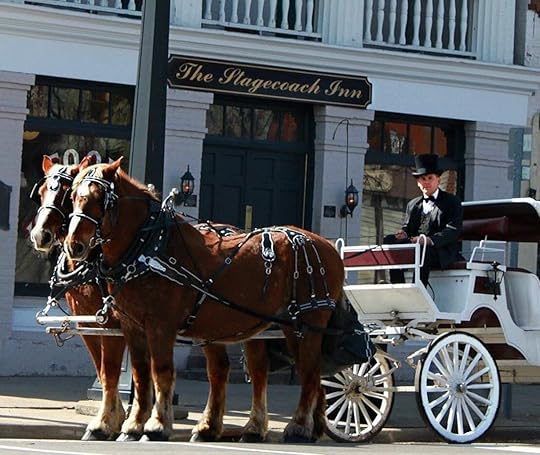
Photo: Marshall Carriage Co. & Ghost Tours/Facebook
Marshall has taken creepy ghost tours to the next level with its horse-drawn hearse wagon tour. You and 14 of your fellow twisted friends can reserve the Marshall Carriage Company for a spine-chilling tour of the town’s historic district and cemetery. You’ll cruise past an eerie hilltop house where former residents dabbled in the occult and the National House Inn, where guests and staff have said to have seen an apparition of a woman dressed in red walking the halls. If you haven’t scared your appetite away, grab a bite at Schuler’s. If you catch a whiff of cigar smoke, that will be the restaurant’s long-dead founder saying hello.
4. Estes Park, Colorado
Photo: Phillip Rubino/Shutterstock
The infamous Stanley Hotel inspired Stephen King’s The Shining, and not only can you tour the hotel, but you can also stay the night. Just don’t take an ax to any of the bathroom doors. Only 90 minutes north of Denver, the 100-plus-year-old hotel had paranormal connections long before Hollywood got its hands on it. Rooms 217, 401, and 407 receive the most complaints from guests and are believed to be haunted. In the time since Jack Nicholson graced the legendary grounds overlooking Rocky Mountain National Park, the hotel has embraced its stardom and even hosts the popular Shining Ball among other Halloween festivities. You can also take part in the Night Ghost Tour year-round.
5. Nashville, Indiana
Photo: Story Inn Bed & Breakfast/Facebook
Drive 20 miles west of Nashville and straight into Indiana’s backcountry to get to the only building still standing in what was once a small mining town called Story. The Story Inn, which sits at the edge of Brown County State Park, has been “one inconvenient location since 1851” according to the B&B’s tagline, but the inn’s ghosts don’t seem to mind the locale. The establishment’s star spirit is the Blue Lady. Believed to be the wife of original village settler Dr. George Story, she is said to appear if you turn on a blue light in one of the rooms. You’ll know she’s been there if you find a random blue object or smell cherry tobacco. If you visit, talk to the owner and ask to read through the many guest books, which are packed with terrifying stories of paranormal encounters.
6. Bentonsport, Iowa
Photo: Mason House Inn/Facebook
Once a thriving port on the Des Moines River, Bentonsport looks much like it did during the 1840s. By day, stroll through downtown and enjoy the charming historic buildings. By night, if you don’t scare too easily, reserve a room at one of the most haunted places in the US: the Mason House Inn. Over the course of the inn’s 175-year history, three owners have died there, and one guest was murdered. The inn served as a hospital during the Civil War, so there’s no shortage of ghosts. According to owner Joy Hanson, at least five spirits occupy the inn: Harold, Amanda, Curtis, Josephine, and Mary.
7. Shepherdstown, West Virginia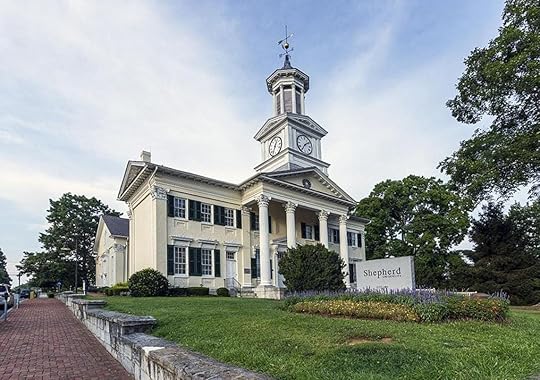
Photo: Historic Shepherdstown & Museum/Facebook
Thirty years older than the US itself, Shepherdstown has been working on its reputation as one of the creepiest towns in America for a long time. Start at the Historic Shepherdstown Museum, formerly the Entler Hotel, which was a gambling hub in the 1800s. You might hear the cries of a young man who died there from wounds he sustained in a duel over a card game. Next, head to McMurran Hall on the campus of Shepherd University. During the Civil War, it served as a hospital, and people have reported seeing shadowy figures peeking out from behind the building’s shutters. After the bloody Battle of Antietam, the present-day home of the Shepherdstown Sweet Shop Bakery was also used as a hospital. It has been said that the original proprietor, who has been dubbed The Colonel, still walks through the shop, and employees have reported feeling something brush past them and often hear muffled conversations. You can learn more about these stories and other legends by taking the Shepherdstown Mystery Walks.
8. Garnet, Montana
Photo: Marty Nelson/Shutterstock
This list of haunted towns would hardly be complete without an actual ghost town. Established in the late-19th century as a gold mining town, Garnet peaked in 1898 when it was home to 1,000 residents. When the gold rush fever died down, the majority of the town’s residents left. The few that remained were forced to leave after a fire destroyed most of the town in 1912. Located in the hills of Montana, Garnet has officially been a ghost town since World War II ended. When visiting, be on the watch for the spirits of past residents. Kelly’s Saloon is thought to be particularly haunted — sounds of music and laughter have been reported to come from the saloon in the dead of winter.
9. Mansfield, Ohio
Photo: aceshot1/Shutterstock
If ghosts manifest in places where they experienced pain in life, it’s no wonder that the Ohio State Reformatory is considered one of the most haunted places in the US. Closed in 1990 for brutalizing and inhumane conditions, the prison housed juveniles for nearly a century. In that time, a slew of violent incidents occurred. In 1948, a prison employee’s wife was kidnapped and murdered. A few years later, the warden’s wife was shot and killed after a gun accidentally fell on the floor. At one point, an inmate killed his cellmate and stuffed his body into a mattress. To see this horrifying place for yourself, take a tour of the crumbling remains. Other haunted places in Mansfield include the Ceely Rose House, Mount Olive Cemetery, and Cry Baby Bridge. 
A version of this article was previously published on September 26, 2018, and was updated on October 25, 2021, with more information.
More like thisEntertainment8 serial killer tours for the true-crime obsessedThese are the prettiest public toilets in the world

When it comes to architecture and design, fancy hotels, record-breaking pools, and intriguing-looking libraries hog the spotlight while the one thing we all need to use daily, the toilet, is consistently overlooked. Indeed, public toilets aren’t exactly known for being architectural wonders. But public toilets don’t have to be grubby, cold, concrete squares that give you the heebbie-jeebies. There are architects, artists, and designers out there who have succeeded in marrying aesthetics with functionality in public toilets. Their bathrooms are inventive, appealing, environment friendly, versatile and welcoming to their users. Here is a look at nine places around the world where you’ll find the most beautiful public toilets.
The Golden Public Toilet — London, England
Photo: Gort Scott
Located near the Wembley Stadium in Greater London, the Golden Public Toilet was designed in 2013 by the Gort Scott architecture and urban design practice. The uniquely geometric building sits within a landscaped pedestrian area at a busy street corner. Inside there are four urinals, an accessible WC, and a concealed tank behind the mirror to collect rainwater for flushing the toilets.
The structure has a roof height of 16 feet with a concrete base. The exterior wall is made with golden aluminum sheeting with diamond pattern perforations in the top half that provide light and ventilation but ensures complete privacy. In the evening, the brightly lit interiors create a surprisingly glamorous effect guaranteeing it to be found easily by the passers-by who need to it.
Two unique public toilets — Colorado and Texas, United StatesThere are many contenders for well-planned public toilets in the United States. The rainwater flush lavatories at the Urban Ecology Center in Milwaukee, WI, are constructed entirely from recycled materials; the Public Glass Bathrooms in Sulphur Springs, Texas have one-way mirrors for walls; and the restrooms of Greeley Square Park and Bryant Park in New York City have luxe touches and are sparkly clean in spite of the many people who visit them every day. But the following are two public toilets that can certainly be considered as the best due to their unique design elements.

Photo: Cintas Best Restroom Award
The Minturn Mining Toilet in the small town of Minturn, Colorado, is a stunning combination of art and architecture in the beautiful natural surroundings of Eagle Town Park. Built in 2015, the restrooms’ design reflects the mining history of Minturn. The fabricated shape of the men’s and women’s toilets mimics an adit (the entrance to an underground mine) in the Rocky Mountains. Made out of 320 wooden pieces and fabricated using 3D printing technology, the toilets with their copper colored walls, are a great example of functional art. In 2015, the Minturn Mining Toilet won America’s Best Restroom Award.

Photo: Miro Rivera Architects
The Lady Bird Lake Trail Restroom in Austin, Texas was the first public toilet to be established in 30 years at the Lady Bird Lake Hike and Bike Trail, that meanders along the Colorado River. Designed by Miro Rivera Architects in 2007, the public toilets are an impressive blend of sculpture and function. The exterior walls of 49 different height panels are made of weathered corten steel that has a natural patina. The panels are embedded in the ground following the natural curve of the trail and ends in a spiral shape that encloses a unisex, accessible toilet.
Kumutoto toilets — Wellington, New Zealand
Photo: Travellight/Shutterstock
The public toilets located on Queens Wharf in the Kumutoto precinct of Wellington, NZ, are certainly eye-catching. Designed by Studio Pacific Architecture in 2011, the toilets have a unique, sculptural look that’s straight out of SpongeBob SquarePants, hence its nickname: “lobster loos”.
Red-colored steel shells are fitted over the series of concentric concrete rings that form the two separate toilets, each ending in a cantilevered tail with a louvered window that provides ventilation. Each structure has a genderless accessible toilet needed for the pedestrians strolling along the waterfront area.
Public toilets along the Norwegian Scenic Routes — NorwayThe many public toilets located along the Norwegian Scenic Routes are all masterpieces of design.

Photo: Morfeus Arkitekter
Along the Scenic Route of Andøya in Northern Norway is the Bukkekjerka Rest Stop, designed by Morfeus Arkitekter in 2018. The design reflects the dramatic landscape by way of the forms and materials used and together they meld with the rugged terrain. Folded concrete slabs make up the restroom building which has one-way mirrors for users to enjoy the surrounding landscape. The building is part of a larger creation which includes a bench, paths, a footbridge and parking and service amenities.

Photo: HZA
The Uredd Rest Area at Ureddplassen along the National Scenic Route Helgelandskysten was designed by HZA in 2018. The rest area is known for its magnificent views of islands, fjords, and northern lights and the wave-shaped toilet building was part of a redesign project for the site of a WWII memorial monument.

Photo: Fortunen
At Skjervsfossen waterfall, is a public toilet designed in 2016 by Fortunen. The stone-clad building rises up, mimicking the steep mountain that faces it. Users can take in the windows through the windows and the glass panels embedded in the concrete floor.
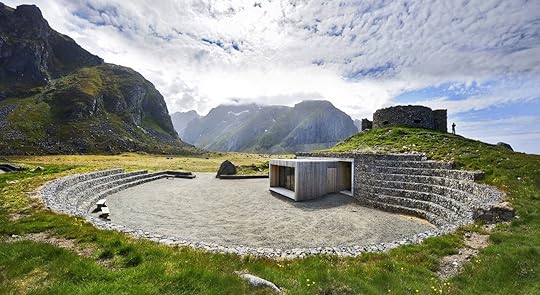
Photo: Snøhetta
The public toilets along the Lofoten Scenic Route are equally spectacular. At the Eggum panoramic site is a public toilet complex designed by Snøhetta in 2007. The box-like projection is part of an amphitheater, all built with local stone and driftwood.
The Tokyo Toilet Project — JapanJapanese toilets are technological wonders to be experienced. No wonder then that Japan has the world’s largest toilet manufacturer in Toto Ltd. But along with the most modern toilets it’s not unusual to find old style squatting toilets in Japan, mostly in public parks and old buildings, resulting in people shunning those facilities.

Photo: Tokyo Toilet Project
The Tokyo Toilet Project was an initiative by The Nippon Foundation to create and improve upon 17 public restroom facilities in the Shibuya district of Tokyo. Sixteen architects and designers, including Pritzker Prize winners, have developed toilets that have become must-visit locations. A house-shaped toilet; a toilet inspired by early Japanese architecture; a cedar-clad facility; a red triangular block based on the Japanese craft of Origata; a facility with frosted glass that shines at night; and the latest to open, a hemispherical, voice-activated toilet — they each has an individual style.

Photo: Sergio Yoneda/Shutterstock
The three Pritzker winners’ contributions are in keeping with their fame. Tadao Ando’s design is a minimalist, elegant circular structure. Fumihiko Maki’s design of four pavilions connected by a single, thin, curved roof is known as the “Squid Toilet”, placed as it is in the “Octopus Park”. But the toilet design that has gone viral is done by Shigeru Ban whose transparent glass wall public toilets are simply extraordinary. When vacant, the toilet’s walls are clear. Once locked the glass frosts over, turning opaque and bathing the park in colorful light.
Old Town Public toilet – Gdańsk, Poland
Photo: Schleifer & Milczanowski Architekci
The city of Gdańsk commissioned the Schleifer & Milczanowski Architekci team to design public toilets in preparation for Gdańsk hosting the EURO 2012. They created the first public toilet within the historic center of the city balancing the modern infrastructure with the architectural heritage of the place.
The accessible toilet is enclosed within a prefabricated cylindrical form that bulges out at the bottom imitating a raindrop. The exterior is fitted with vertical, striated steel ribs that also function as a bike rack. They have a rusted patina and extend upwards to resemble tenement rooftops. The roof is transparent, negating the need for artificial lights.
Museum of Islamic Art Park public toilet — Doha, Qatar
Photo: PEI Architects
The Museum of Islamic Art Park is a 70-acre park adjoining the Museum of Islamic Art in Doha, Qatar. The museum is a masterpiece by the legendary I. M. Pei, architect of the Louvre pyramid. The MIA Park, a public space designed on an artificial extension on the Doha waterfront, was completed in 2012 and has kiosks serving as a cafe, a restaurant, and public restrooms.
The kiosks including the public toilets are placed under a series of triangular tensile structures that complement the flow of the surrounding hillocks. The exteriors of the restroom kiosks are decorated with flower motifs.
The Light Box Restroom — Thane, India
Photo: RC Architects
The Light Box Restroom is a concept from RC Architects, the studio of Rohan Chavan whose unique approach towards public sanitation has brought forth modern designs rooted in tradition.
The first of a series of public toilets built in several cities, The Light Box, created in 2016 is placed on the side of a busy highway in the Mumbai metropolitan area. Created exclusively for women, the restrooms function as a safe haven and a socializing area. The toilet block with its hot pink flooring is built around an existing tree that provides shade and aids in filtering the natural light. The complex of three toilets and a nursing room has a central garden used as a resting spot and provides gallery space for art. 
Matador Network's Blog
- Matador Network's profile
- 6 followers



